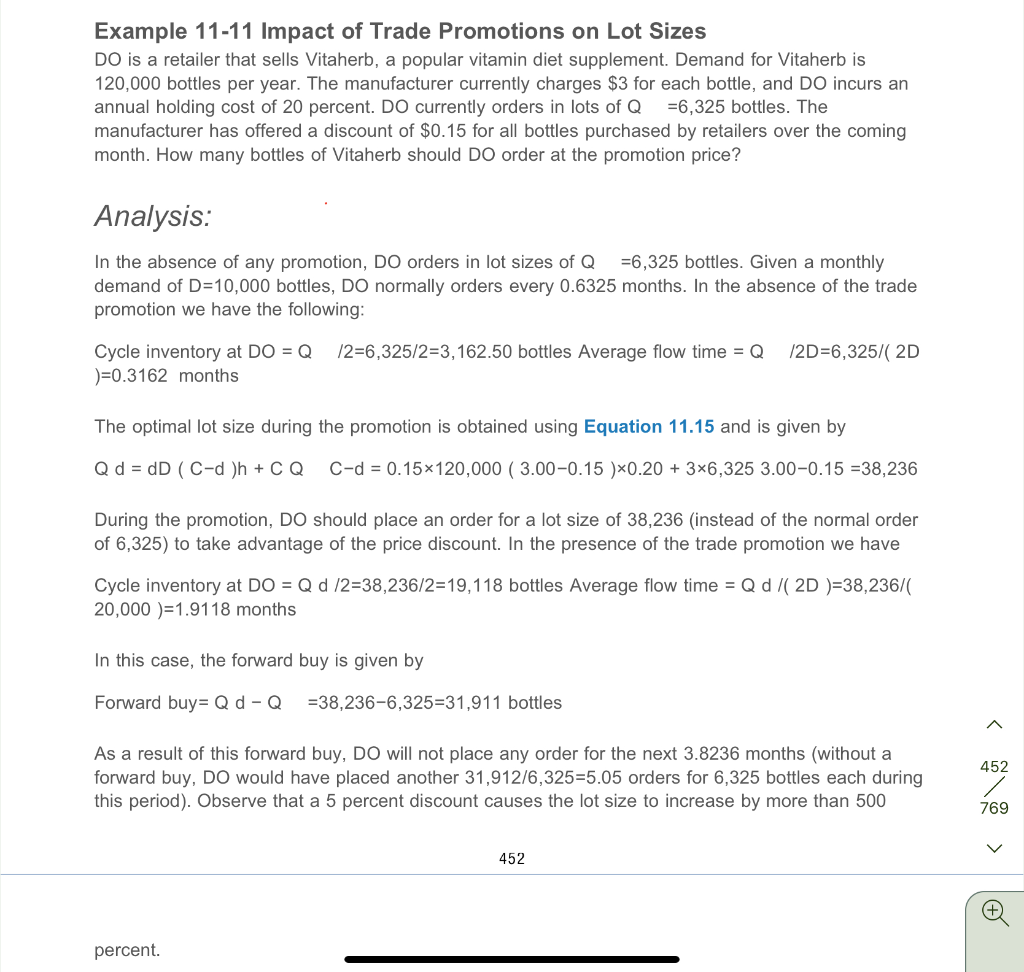
- Review the example 11-11 (pp. 295-296) worked out in the book and give your justification of large increase in purchase quantity in response to a small price discount (5%). This example shows impact of price discount on purchase quantity. Use order cost of $100/order. Develop an annual cost model by combining the cost of purchase, ordering cost and inventory holding cost to justify the result? The example relates to one time price discount followed by return to normal EOQ based purchasing behavior.
Example 11-11 Impact of Trade Promotions on Lot Sizes DO is a retailer that sells Vitaherb, a popular vitamin diet supplement. Demand for Vitaherb is 120,000 bottles per year. The manufacturer currently charges $3 for each bottle, and DO incurs an annual holding cost of 20 percent. DO currently orders in lots of Q =6,325 bottles. The manufacturer has offered a discount of $0.15 for all bottles purchased by retailers over the coming month. How many bottles of Vitaherb should Do order at the promotion price? Analysis: In the absence of any promotion, DO orders in lot sizes of Q =6,325 bottles. Given a monthly demand of D=10,000 bottles, DO normally orders every 0.6325 months. In the absence of the trade promotion we have the following: /2=6,325/2=3,162.50 bottles Average flow time = Q 12D=6,325/( 2D Cycle inventory at DO = Q )=0.3162 months The optimal lot size during the promotion is obtained using Equation 11.15 and is given by Qd = dD (C-d)h + CQ C-d = 0.15x120,000 (3.00-0.15 )*0.20 + 3x6,325 3.00-0.15 =38,236 During the promotion, DO should place an order for a lot size of 38,236 (instead of the normal order of 6,325) to take advantage of the price discount. In the presence of the trade promotion we have Cycle inventory at DO = Q d /2=38,236/2=19,118 bottles Average flow time = Q d /( 2D )=38,2367 20,000 )=1.9118 months In this case, the forward buy is given by Forward buy=Qd-Q =38,236-6,325=31,911 bottles 452 As a result of this forward buy, DO will not place any order for the next 3.8236 months (without a forward buy, DO would have placed another 31,912/6,325=5.05 orders for 6,325 bottles each during this period). Observe that a 5 percent discount causes the lot size to increase by more than 500 769 452 percent. Example 11-11 Impact of Trade Promotions on Lot Sizes DO is a retailer that sells Vitaherb, a popular vitamin diet supplement. Demand for Vitaherb is 120,000 bottles per year. The manufacturer currently charges $3 for each bottle, and DO incurs an annual holding cost of 20 percent. DO currently orders in lots of Q =6,325 bottles. The manufacturer has offered a discount of $0.15 for all bottles purchased by retailers over the coming month. How many bottles of Vitaherb should Do order at the promotion price? Analysis: In the absence of any promotion, DO orders in lot sizes of Q =6,325 bottles. Given a monthly demand of D=10,000 bottles, DO normally orders every 0.6325 months. In the absence of the trade promotion we have the following: /2=6,325/2=3,162.50 bottles Average flow time = Q 12D=6,325/( 2D Cycle inventory at DO = Q )=0.3162 months The optimal lot size during the promotion is obtained using Equation 11.15 and is given by Qd = dD (C-d)h + CQ C-d = 0.15x120,000 (3.00-0.15 )*0.20 + 3x6,325 3.00-0.15 =38,236 During the promotion, DO should place an order for a lot size of 38,236 (instead of the normal order of 6,325) to take advantage of the price discount. In the presence of the trade promotion we have Cycle inventory at DO = Q d /2=38,236/2=19,118 bottles Average flow time = Q d /( 2D )=38,2367 20,000 )=1.9118 months In this case, the forward buy is given by Forward buy=Qd-Q =38,236-6,325=31,911 bottles 452 As a result of this forward buy, DO will not place any order for the next 3.8236 months (without a forward buy, DO would have placed another 31,912/6,325=5.05 orders for 6,325 bottles each during this period). Observe that a 5 percent discount causes the lot size to increase by more than 500 769 452 percent







